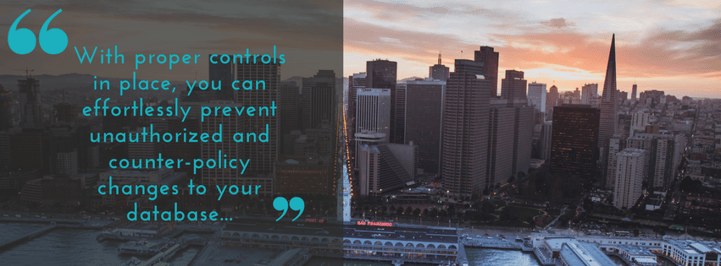Managing continuous database changes is crucial for keeping your company competitive and efficient. However, this process comes with significant challenges, as approximately 80% of unplanned database downtime is attributed to these changes. Let’s explore the complexities of database auditing and continuous change management, along with best practices to overcome common obstacles.
What You’ll Learn
- Common challenges in managing continuous database changes
- Best practices for database change management
- The role of DevOps and database auditing in ensuring error-free continuous change
- Emerging trends in continuous database change management
3 Common Challenges in Managing Continuous Database Change
Challenge 1: Capturing Configuration Changes in Continuous Database Change
Accurately tracking small, frequent changes across complex systems spanning web, cloud, and mobile environments can be daunting. Organizations often struggle to maintain visibility into these incremental modifications, leading to potential conflicts and inconsistencies.
Challenge 2: Reducing Errors in Deployment and Production
Minimizing deployment errors requires a shift from traditional methodologies to more agile approaches. Implement continuous testing and automated deployment processes to catch issues early and reduce the likelihood of errors making it to production.
Challenge 3: Addressing Rollback Limitations in Continuous Database Change
Developing effective rollback strategies is essential in agile environments. Implement version control systems and create snapshots before major changes to facilitate quick and seamless rollbacks when necessary.
Pro Tip: Implement automated rollback mechanisms to quickly revert problematic changes without disrupting production environments. This ensures minimal downtime and preserves system stability.
DB Change Management Best Practices
Organizing Code, Metadata, and Configuration in Continuous Database Change
Structuring and categorizing changes during development is crucial. Organize modifications into distinct categories: code changes, continuous database changes, configuration changes, and metadata changes. This approach allows for better tracking and management of each change type.
Why Batch Deployments Can Lead to More Mistakes
Contrary to popular belief, deploying all changes at once doesn’t save time. Instead, it often leads to more errors as individual changes aren’t properly evaluated. Implement a granular approach to deployments, allowing for better control and easier troubleshooting.
Pro Tip: Schedule regular database audits to identify potential issues early and maintain compliance. Combining audits with automated tagging ensures seamless tracking of all changes.
DevOps, Database Auditing & Error-Free Continuous Change

Integrating DevOps into Database Management for Continuous Change
Uniting development and operations teams under DevOps principles can significantly improve database change management. This collaboration ensures better communication and smoother transitions from development to deployment.
Smart Tools for Database Auditing in DevOps
Leverage tools such as enforced database source control, database build automation tools, and database verification processes to transform your database into a stable resource within the DevOps toolchain.
The Role of Audit Trails in Ensuring Database Security
Implementing comprehensive audit trails is crucial for maintaining database security and compliance. These trails provide detailed information on who made changes, when they were made, and why, enabling better oversight and quick issue resolution.
Emerging Trends in Continuous Database Change Management
As database auditing and continuous change management evolve, several trends are emerging:
- AI-driven change monitoring for proactive issue detection
- Predictive analytics for anticipating potential database conflicts
- Low-code/no-code database change tools for streamlined processes
Putting it All Together: Smarter Practices, Better Outcomes
By implementing a well-defined, enforced, and monitored database continuous integration policy, coupled with robust database auditing, organizations can effectively manage continuous changes while minimizing risks.
- Key Takeaways
- Automate database auditing processes to ensure policy compliance
- Implement DevOps practices for better collaboration between development and operations teams
- Utilize smart tools for database source control and build automation
- Maintain detailed audit trails for enhanced security and troubleshooting
- Stay informed about emerging trends in database change management to remain competitive
By following these best practices and leveraging modern tools, companies can navigate the complexities of continuous database changes while maintaining system integrity and performance.
Conclusion: The Future of Database Auditing and Continuous Change
Continuous database change management is no longer a luxury but a necessity in today’s rapidly evolving technological landscape. As organizations increasingly rely on complex, interconnected systems, the ability to manage database changes efficiently and securely becomes paramount.
- The convergence of DevOps principles, advanced auditing tools, and emerging technologies like AI and predictive analytics is transforming how we approach database management. By embracing these innovations, organizations can:
- Minimize operational risks
- Enhance system reliability
- Improve overall IT infrastructure efficiency
- Maintain robust security and compliance standards
While challenges remain, the future of database auditing looks promising. Companies that invest in comprehensive change management strategies, leverage cutting-edge tools, and foster a culture of continuous improvement will be best positioned to succeed in the digital era.
Remember, successful database change management is not about eliminating changes, but about controlling, tracking, and implementing them with precision and confidence.
Final Recommendations
- Continuously educate your team on best practices
- Invest in robust database auditing tools
- Maintain a proactive approach to change management
- Regularly review and update your database change strategies
By following these guidelines, organizations can transform database changes from potential risks into strategic opportunities for innovation and growth.





